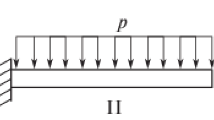Abstract
The leaf spring is a representative type of laminated structure. Based on the linear theories of curve beams, the first derivatives of the leave’s status-vector of the leaf spring are provided. The first derivatives of the combination status-vector are obtained by properly dealing with the nonlinear interacted forces between adjacent leaves. Moreover, the precise integration technology and the transform matrix method are introduced to solve the equations. The force-displacement curve of a leaf spring is then calculated separately by using the present method and the finite element software ANSYS. From the results, the precision and advantages of the present methods for analyzing the leaf spring are revealed. The Coulomb’s damping ratio of the leaf spring is studied by using the present method.
Similar content being viewed by others
References
M. A. Osipenko, Yu. I. Nyashin and R. N. Rudakov, A contact problem in the theory of leaf spring bending, International Journal of Solids and Structures, 40(12) (2003) 3129–3136.
E. Zahavi, Analysis of a contact problem in leaf springs, Mechanics Research Communications, 19(1) (1992) 21–27.
M. M. Shokrieh and D. Rezaei, Analysis and optimization of a composite leaf spring, Composite structures, 60 (2003) 317–325.
N. J. Nigro and S. P. Bhatia, Equivalent one-dimensional system for analysis of taper leaf springs, Journal of Engineering for Industry, Transactions of the ASME, 98(1) (1976) 39–42.
H. Sugiyama, A. A. Shabana, M. A. Omar et al., Develop of nonlinear elastic leaf spring model for multibody vehicle systems, Computer methods in applied mechanics and engineering, 195 (2006) 6925–6941.
A. R. Muhammad and A. K. Muhammad, Inelastic deformations of stainless steel leaf springs-experiment and nonlinear analysis, Meccanica, 45 (2010) 503–518.
W. Zhong, On precise time-integration method for structural dynamics, Journal of Dalian University of Technology, 34(2) (1994) 131–136.
W. Wu, Y. Xiang and J. Chen, Analyze the stiffness of leaf springs based on precise integration technology, Journal of Wuhan University of Technology, 32(10) (2010) 78–81.
Y. Xiang, Y. Huang and J. Huang, A method of homogenization of high precision direct integration, Journal of Huazhong University of Science and Technology (Natural Science Edition), 30(11) (2002) 74–76.
W. Ji, T. Fang and S. Chen, The variation of mechanics, Science Press, Beijing, China (1985) 81–84.
Author information
Authors and Affiliations
Corresponding author
Additional information
Recommended by Associate Editor Heung Soo Kim
Wen-jun Wu currently works as a lecturer at the Department of Automobile Engineering at GuangXi University of Technology, China. He is also currently pursuing his Ph.D at the Beijing Institute of Technology, China. His research interests include computational mechanics, attitude control of spacecraft, and vibration control of complex structures.
Le-mei Zhu is a Ph.D candidate from the Beijing Institute of Technology, China. Her research interests include adaptive control, spacecraft attitude control, and sloshing suppression.
Rights and permissions
About this article
Cite this article
Wu, Wj., Zhu, Lm., Yu, X. et al. Novel method for equivalent stiffness and Coulomb’s damping ratio analyses of leaf spring. J Mech Sci Technol 26, 3533–3538 (2012). https://doi.org/10.1007/s12206-012-0866-9
Received:
Revised:
Accepted:
Published:
Issue Date:
DOI: https://doi.org/10.1007/s12206-012-0866-9




